
 |
The Internet's Largest and Fastest Growing Engraving Community
Discuss hand engraving using basic to the most advanced methods and equipment
Forum Members: 14,762. Welcome to our newest member, Katherine
EngravingForum.com -
Domain since Feb 7, 2003
 Graver Video Conferencing is empty Join now!
Graver Video Conferencing is empty Join now!
|
|||||||
| ENGRAVING TOOLS - Paypal accepted | Classes | Glossary | Feedback | Tips | Sharpening | Bulino | Videos | Forum Policies |
 |
|
|
Thread Tools |
|
#51
|
||||
|
||||
|
Quote:
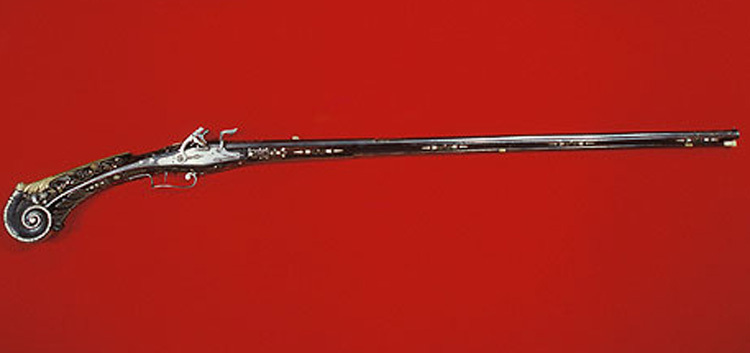 Also, there are numerouse references to The gentlemen (Like the king William III & George III), getting together & having shooting matchs witheir "fine guns" Also, there are numerouse references to The gentlemen (Like the king William III & George III), getting together & having shooting matchs witheir "fine guns"Remember the Ornate swords these guys carried into the field. Or better yet, those "ornate" Pen/KYs ("richly carved" IMHO = wall hangers Note- Wait until you see the "scots pistols" (they were used - example- The 1st shot in the Rev. war, was fired from an ornate scots pistol.) Puffer |
|
#52
|
|||
|
|||
|
i think puffer is correct , many times these works were simply show pieces . However other times they were used . Pop documents many examples of highly ornate wheel locks that show the corrosion and patina of use .
Also many time these were weapons specifically done for royalty others not . Most certainly as he said they probably were not weapons for the common man though through time they found their way into the hands of the common people . Puffer would you have any documentation of celtic type engravings done or period weapons ? |
|
#53
|
||||
|
||||
|
Quote:
Puffer |
|
#54
|
||||
|
||||
|
As I mentioned before,, the "fine Gun Makers in Britan, did most of their engraving in house.According to my resourses, most of their guns had at least some engraving. Here are some pics of engraving on some of their plainer pistols.
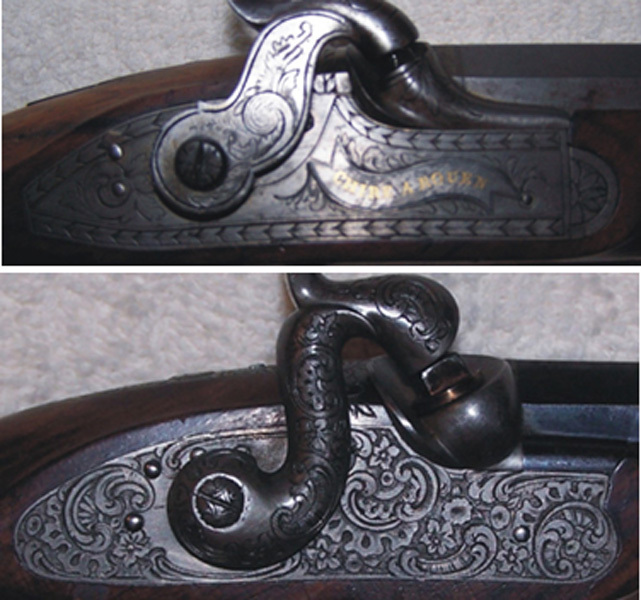 here are my favorite 2 lock & lock plates  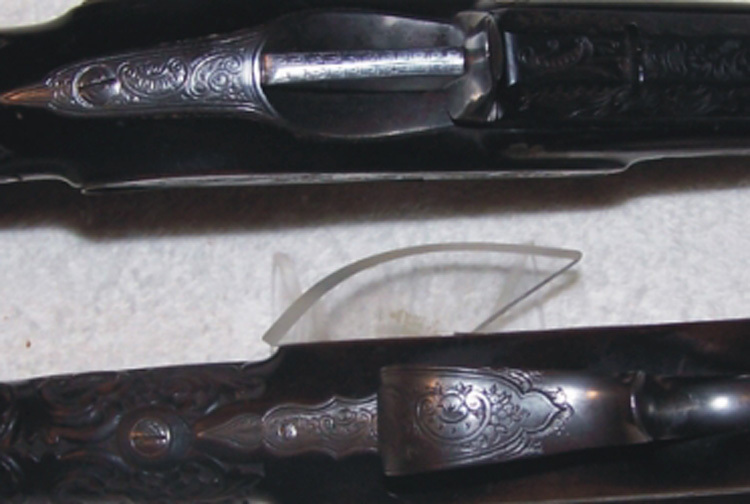 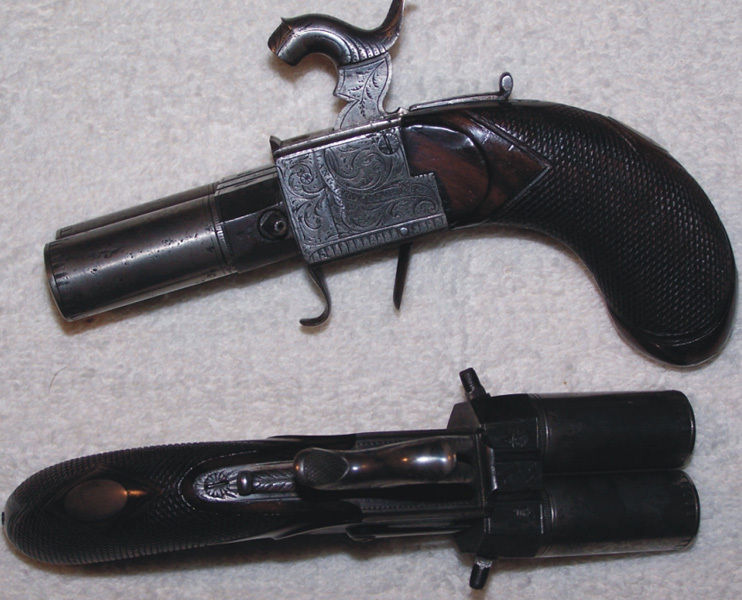  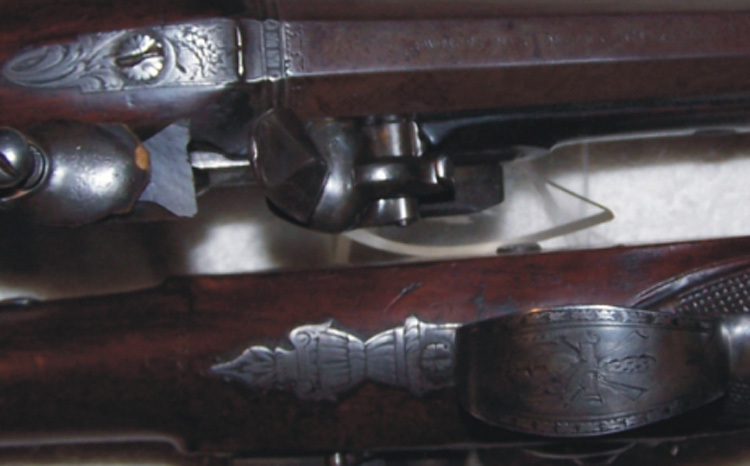 Puffer |
|
#55
|
||||
|
||||
|
Puffer
Thanks for the info // The pictures that you last posted IMO are ones that would have been used and very well done//still not a common mans gun but most certainly one I belive would have been seen and used on a regular basis. |
|
#56
|
||||
|
||||
|
Do you think that you see more engraving in the 18th century on fowling guns rather than a rifle or perhaps more on pistols // Just my observation but it seems to me I see more fowling pieces // much like more modern times and today like on shotguns // just an opinion what do you think?
|
|
#57
|
||||
|
||||
|
Quote:
1. yes, these examples are from the "finer gun makers" = Egg, Forbes, Mortimer etc. as opposed to ketland,Wilson etc. 2. But what is a "common man" ?? You may recall that David Thompson ( a surveyor, Northwest Co. explorer , map maker etc. Mid income ) carried a pair of Mortimers pistols. Also it is documented that the Amer. fur Traders were familiar with Manton's rifles (another "fine gun maker") In fact at least one was @ a rendezvous, carried by a Brit.) Puffer |
|
#58
|
||||
|
||||
|
Good points Puffer
I guess it does depend on your interpretation of Common Man What do think a Scotsman would have had for engraving in the mid to late 1700's after he had been in the country for a bit // Just my guess but he probably didn't have much when he first came over and hit the ground. |
|
#59
|
||||
|
||||
|
Quote:
I do know that a "scots dog lock" was found @ Jamestown VA (dated 1607) But did any "Scots" engravers come over ?? If so what "pattern guns did they make ?? I do not Know. My "assumption" is that if they did come over, they practiced their trate making "local" guns. Puffer |
|
#60
|
|||
|
|||
|
ok so lets keep this all tied together here fellas which i think we are doing .
do you all think that this heavy ornamentation slowed down because of guarding of secrets or was it simply change . if i get the jest of what your getting at here puffer is that maybe the move came about as gunsmiths started losing the ability to do this engraving . or is it maybe because they slowly moved to providing simpler works for the common person ? How about the laws passed by the crown in the 18th century , did they have an effect you think ? |
|
#61
|
|||
|
|||
|
I tell you guys this has been a great thread.
 The historical stuff is beyond my area of expertise so I really can't participate much but I have loved the pics and it has been a very good read.:thumbsup: The historical stuff is beyond my area of expertise so I really can't participate much but I have loved the pics and it has been a very good read.:thumbsup: Ry |
|
#62
|
||||
|
||||
|
Quote:
1. The guns themselves. -- The "early guns" were LARGE to say the least. Therefore they offered the engraver a a larger canvas to work with. As the guns became more diminutive, the decoration followed suite. ( imagine an 19th centry dueling pistol or sporting rifle, or fowler, with the type of engraving you first posted ???? Even with the "ornate" guns I posted, we see inlays & finer engravings. 2. Personal taste availability & usage.-- Originally guns were a "rarety" & EXPENSIVE & very few had them.As the guns developed & their usage became more "common" the engraving became more "practical" Even the "bey of Tunis' gun I showed could be carred & used. IMHO, THE HISTORICAL DEVELOPMENT of the GUNS & the DECORATION of GUNS CAN NOT BE SEPERATED !!!! Puffer |
|
#63
|
||||
|
||||
|
Puffer / Anyone
Do you think the more ornate engravers were in Europe // Did they make the trip to the New World??? or did we begin to loose the really ornate and begin with simpler engraving as more movement happened in the Colonies. I know we had fine gun makers who engraved but could they have started to become less ornate and more affordable to compensate lack of retail customers (so to speak) and increasing makers coming in. In other words put what they need and could afford (in the hands of the few) rather than what they wanted and could not? |
|
#64
|
|||
|
|||
|
you know i was thinking about this last night and i realized something here .
do not many of the Asian countries still do this heavy type of relief work ? I seem to recall while in the army seeing a lot of items done this way both in silver and such for sale by street merchants . The Philippines and Korea come to mind . I do remember the Buddhist temple where my wife and I were married had some very heavy open type works in a lot of different metals as well as wood with large amounts of inlay work and seen depictions I seem to recall this work quite common there among artisans. Did these peoples not go through something that Europeans did ? I think maybe your on the right track in what you say puffer but I also wonder this . During the times of this type of work . What was happening ? Spain , France , England in fact most of Europe was in some stage of war . History has showed us that during these time technologies often advance but the arts lose ground . In times of relative peace this turns the opposite direction. Could we not be sing the effects of this as these weapons makers turn to making more military works over highly decorated pieces ?. Later we have the French revolution during which a lot of anything concerning autocracy or items showing a person status as more wealthy then another was destroyed as I understand it even frowned upon being produced . Did not Russia go through much the same change during the communist revolution ? Surly when the revival of the arts did happen , as it always does , would it not come back changed , losing something from the past but creating a different interpretation of the mind set at the time ? now these are later reproductions and castings but . from what i understand especially during the late 17th century and well through to the French revolution, even the smallest items like snuff boxes would have been highly relief engraved . so doesnt this negate the size issue ? thoughts ? 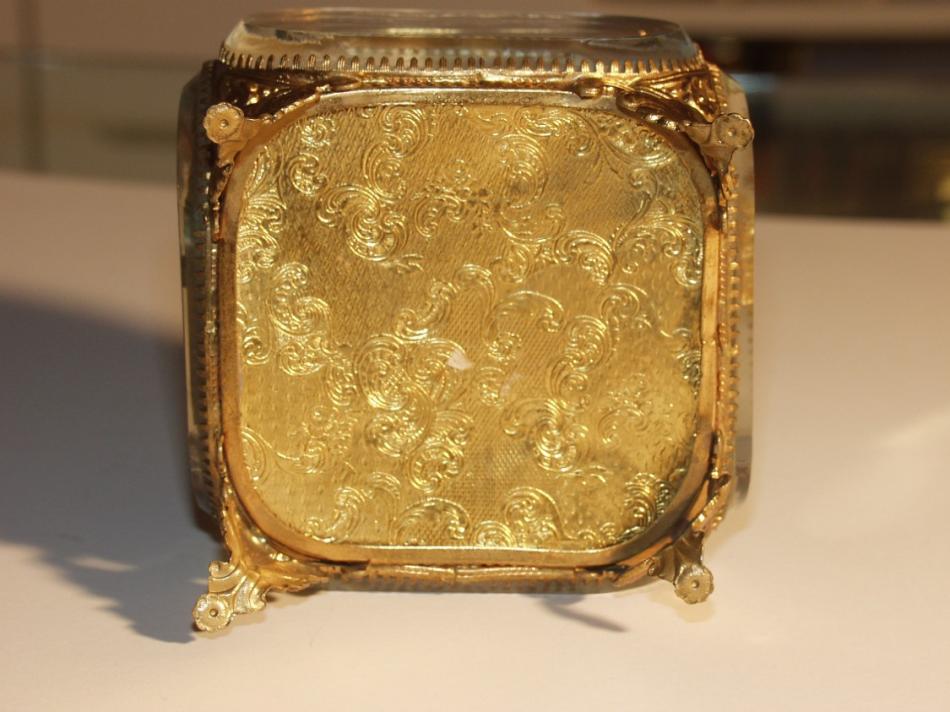 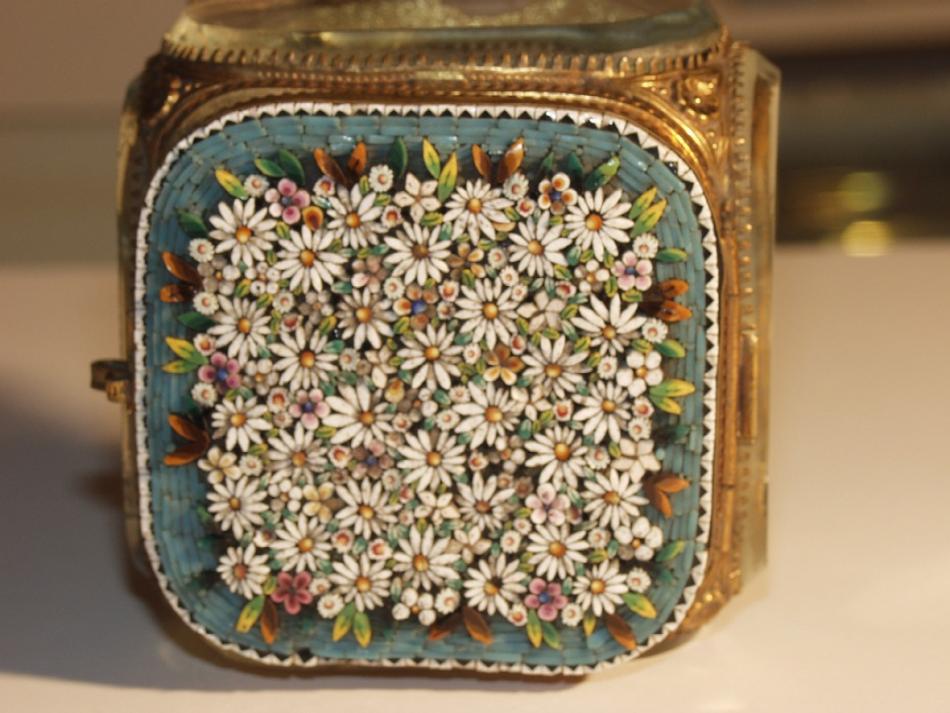 take a look at this rare 19th century Napoleon III jewelry cascet with four thick beveled sides set in a decorated gilt frame. On top there is a large micromosaic richly decorated with white daisies on a turquoise ground. The item is originated in France and dated second half of the 19th century. The box is in excellent condition with no tesserae missing and the interior tufted satin is original. Micromosaic : Length: 10cm Width: 10cm Height: of the box: 9cm we may lose this link so look fast . but if you look at the bottom and then the overall presentation its maybe a transition peice of old styles and the biging of the newwer scroll work we see so often today http://www.rubylane.com/shops/chateau/item/080 |
|
#65
|
|||
|
|||
|
This elaborate or excessively done engraving does nothing for me. Would you know of any illustrations of 18th century period styling that might be considered "simple" in design. Thanks!
|
|
#66
|
||||
|
||||
|
Although tis is not engraving, I thought you all, might like to see this lock. It was made in the ealy 1600s for a German matchlock sporting rifle ( yes Gobbler these guns were used to hunt with )
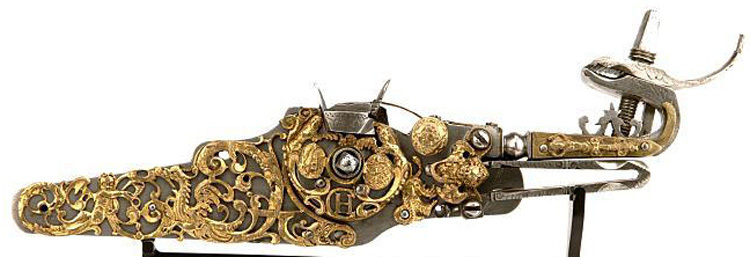 Puffer |
|
#67
|
||||
|
||||
|
Quote:
This Thread has been an eye opener to me.For years, I have seen the beautiful engraving done on muzzle loading guns. ( even have collected a few pics etc of the "ornate ones) just for the enjoyment of the ART. But I have realized 2 things (even @ my advanced age, I still can learn.) Here is how I, personally, would like your imput. ( plus any other engravers on the forum ) 1. Engraving is an ART. :whoo: I have "lurked" in other sections of the forum & I have REALY come to appreciate the work & ability it takes. As I have been researching, I have seen on the earlier guns, engraving,casting, sheet work etc. Could you please point out ( on the examples I have posted {& others I will post} what is what ??? 2. For this thread, I am putting together a series of posts, featuring the Scotish Pistols. The reason being, that these guns, until the mid-late 1800s, were engraved (some lavishly) And IMHO gives us an example of the transition fron the very ornate to the more "simple" Here is my problem - a. The engraving & decoaration, is one of the ways a gun is dated & authenticated as being made by a Scotish gun maker (ep. the early ones) But I keep running accros the terms - German style, mid-European style etc. At any given date what were these "STYLES"??? I also keep running into "patterns ( running foiage,pllmette leaves, rosettes,romanesque etc. As I post the guns, can you (or others) assist in clarifing ?? Puffer |
|
#68
|
||||
|
||||
|
I'm very partial to British flintlocks and Scottish examples are really quite unique.
Some of these links are probably familiar to you, but hopefully you'll gain some use from others: Scottish firearms Scottish dueling pistols a Highland pistol Arms and Armour at Glasgow Museums various books of Scottish arms Marischal Virtual Museum Scottish steel pistol c. 1750 cased pair of Scottish dueling pistols c. 1800 the National Firearms Museum (American) |
|
#69
|
|||
|
|||
|
Charles, do you know what percentage of the engraving that smiths do today is by hand or pnuematic?
|
|
#70
|
|||
|
|||
|
puffer ,Please lets be sure to keep things tied in here on the discussion and how it relates to the change . Everything needs to relate to the original topic at hand in some way . IE what changed , how it changed and opinions or questions as to why .
did this type of engraving simple decline to only a few people doing it OR did it naturally turn to something else . if so what . what was the evolution . can we show that transition, can we document it . Did all the European engravings go through this change or was it simply American artists beaverman . I would say probably about 50 , 50 many folks clearly use Pneumatics , others strictly frown on it as not being correct for what we do . However my take is that only a very learned person can tell the difference been a very long day fellas , sorry for being so blunt, |
|
#71
|
||||
|
||||
|
Whether pneumatic tools are used or not, it is considered "by hand". The hand guides the tool without any help or direction. If someone were to build a flintlock rifle from a blank, but used a band saw to rough out the blank, would it no longer be "hand" made?
Just to clarify, a powered engraving tool is not a machine, as i define the term. An engraving machine, or machine engraving itself, would be the device or process where a pre formatted template or set of instructions causes a device to automatically produce a certain output. The operator may have varying degrees of involvement in the process, but the defining difference is the guidance or automatic control provided by the device. Actually, you could argue that machine engraving is not engraving at all. The pantograph machines actually do not remove metal, but displace, or scratch the metal, producing a mark that becomes part of a design. lasers burn, they do not cut, and even the output of rotating cutter type machines might be more properly called "machining" as opposed to engraving. Do powered tools give some advantage? yes, that is why many of us use them. Do they transform what we do so that it is no longer "hand" engraving? Absolutely not. Just a point of information! :window: take care, Tom PS I'll try and help identify whatever types of work i can. For example, those pictures of the mirrors posted above would represent repousse, not engraving. Or perhaps some sort of die forming process was used. The engraving would have been on the dies themselves. The monogram on the one would be engraving. That is AFAIK, anyway. Tom |
|
#72
|
|||
|
|||
|
Quote:
Basically that’s the change we are talking about here . Why the change from what is being shown to works that are more like this 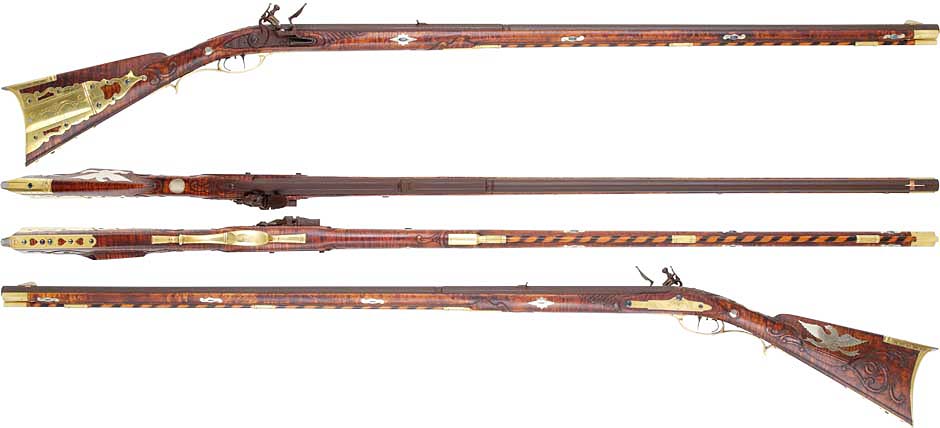 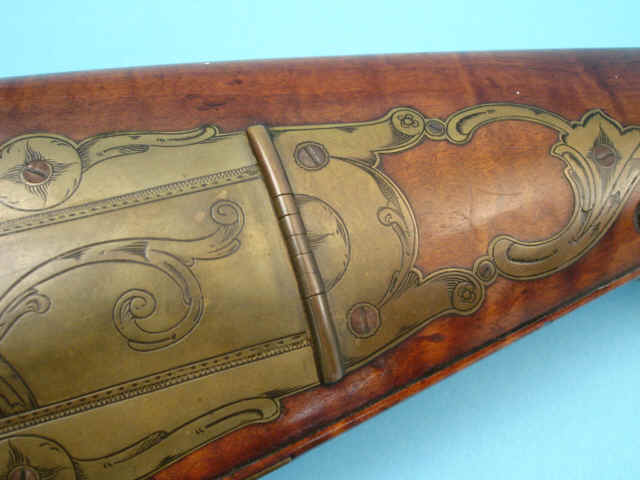 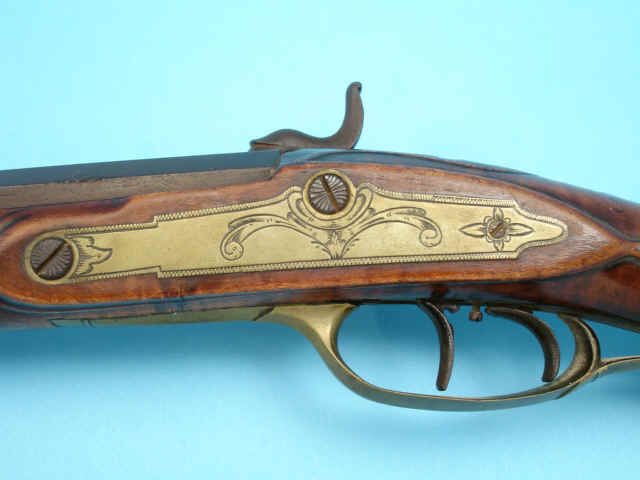 John Armstrong was know for being extravagant in his building then many of the other American smiths of the time frame as you can see there was a drastic change that seemed to happen rather suddenly Quote:
But still castings all the same . They are20 century copies of 18th century works . while they clearly are not engravings , they are castings . the reason i posted them was to suggest that maybe there was a tendency to say why pay for actual engravings when it was much cheaper to cast of of an original ? could this be part of the decline of heavy relief works ? i don’t know , thats what were discussing . there is literally thousands of different things that happened in this time period that i believe probably caused this change and is still reflected in today’s works As to Pneumatics . The point isn’t whether the engraving is still done by hand or not but more to if it is done correctly . Continues blade saws , long blade , saws even wheel saws would still be correct . But if you got tight down to the nit of it , it would be the power source that wouldn’t be correct as we use electricity and the original type mill saws used water power OR in some cases treadle power or recoils of iron or wood to create the power to turn the tools such as with original period wood laths. Many folks do use simply coping saws to cut the blanks . Others like myself use a band saw to cut a plank but then only use rasps , files , gouges and chisels from there forward . The use of a dermal tool or rotary tool for carving is frowned on by many folks to include myself . it’s a very good way to mess up a build. don’t get me wrong , they have there place , just not on the same table as the rifle . What I am getting at however is that there is a level of gunsmith that builds these rifles today that do them exactly the same way as 200 years ago . Right down to forging their own Iron barrels and locks to using brace and bits and only hand tools , no electronics what so ever . Some go so far as to have no power tools at all within their shops. Fopr some its not enough to be made by hand , it must truly be made by a historical correct hand |
|
#73
|
||||
|
||||
|
Quote:
As an engraver,I have seen very few American engravings that even approached the quality found on the best contemporary European work. In my limited experience, the best decorative work being done in early America was on silver or furniture. Even in the days of Nimshcke and Young, the best engraving in the world was being done in Europe. Until very recently, the quality of engraving done in the US could not compare very well with the best European work. I am an opinionated curmudgeon, but my experience has shown that most gun writers know very little about the difference between varying degrees of quality in the engravings they write about. If someone likes what they see, that is great. But it does not necessarily mean that the work is well designed, or even well executed. This book- http://www.amazon.com/Gunmaking-Doub...5811007&sr=1-1 has a couple of great chapters on engraving, that will help you learn how to evaluate what you see better. There are some great photos of some of Winston Churchill's work in that volume as well. Also, Ron Smith's first book on scroll design http://www.contenti.com/products/books/116-614.html can be of great help in that department also. It is a more thorough treatment of the subject. The early American artisans , in my opinion, were more praiseworthy for their persistence and resourcefulness, not the absolute quality of their work. Their work is sometimes very beautiful, and often the European work, to my eyes, could be grossly overdone, and not beautiful at all. However, generally speaking, we are talking about two different worlds. To simplify it, I see two basic reasons for the "sudden decline" in the quality of engraving, which really is not a decline at all. What we see, I believe, is more average quality artisans getting their work noticed and appreciated, because they did not have the competition over here,from the very best that were still in Europe, and the fact that we Americans have taken more note of them, because they are our artisans! Their work stood out on a rugged frontier, and in a provincial society, in a way they would not have stood out in London, Berlin, or Paris, just to name a few places of note. The early American engraver was either not capable of producing the quality of work that was being done by the best in Europe, or he did not have the patrons who were wiling or able to pay for it. take care, Tom |
|
#74
|
|||
|
|||
|
good post tom , surly something to think on

|
|
#75
|
||||
|
||||
|
Historically correct? That is a can of worms!:willy_nilly:
    Anyway, according to Peter Alexander, most gun makers were stocking guns, using barrels, locks, and sometimes even furniture imported from Europe, or produced by specialists here. Sometimes, as in Salem NC, the engraving may have been done by a local specialist, ie. John Vogler. Everyone has their own threshold, and i respect that. There are so may ways we really cannot duplicate the conditions those guns were produced in, and there are so many things we don't know that we don't know about. Anyway, I respect and applaud your efforts, and those like you. certainly a great discussion you started! If you do win the tool, please do post some pictures of your work, when you feel comfortable doing so. take care, Tom |
|
#76
|
||||
|
||||
|
BTW, if those forms you showed were solid, casting would fit. if they are hollow, i would think the were formed in dies out of thin sheet. Much more economical, but then again, i don't know much about those things. The few combs and mirrors i have engraved were very very thin. I can't imagine that they were cast.
Tom |
|
#77
|
||||
|
||||
|
Quote:
Quote:
This was the question I posed in my earlier thread that he answered but I'm wondering does anyone else think that why It is Tom's thoughts but I was just posing a theory What do think? Was it disposable income or did those makers/Engravers stay in Europe? Anyone have any links to reference makers coming over ? Don't want to beat this to death but just wondering Thanks |
|
#78
|
|||
|
|||
|
im sorry tom i missed this part again its been a very long day
Quote:
i think all these comparison being shown , are actually leading us down that path of trying to figure this out . i think the answer can be very simply but as often the case , the simple answer has allot of context to it . myself i dont see how we can try to understand this topic without also understanding the different venues of period engraving or other arts which happened at the same time . as we look at these different photos of different time periods , i think we start to see how it all ties together to show a progression of change Maybe what we are seeing is a refinement of that art over a short 100 to 150 year timeframe . But if thatís the case then why have we not seen this same refinement over the last 150 years as America became one of the wealthiest nations in the world ? |
|
#79
|
||||
|
||||
|
Quote:
In terms of history and depth of tradition, we may never equal Europe. If Beretta stays in existence, we will never have a company in our country with that much longevity. maybe we are finally catching up in the area of the engraving arts. Why has it taken so long? I don't know. maybe Americans generally like the look and feel of real wood more than the real thing? Off to work now! Tom |
|
#80
|
|||
|
|||
|
Tom, Casting is often done with cavities especially on larger pieces .
Any of the processes of sand casting , lost wax castings even lost mould casting can all provide such items Ok here is what I think happened . Now this may be long so please read through as my writing gets worse the longer the post We start of f in the 17th century , what was a commonality among most of the many of the European countries ? Basically religion especially the catholic church . We also have to add a class system with great separations between the lower , middle and upper classes. Now we mix in the wars between France , Spain and England . Both being carried out before and after this time frame. Now enter production and emigration to the new world IE the Americas and the vast wealth found there . Now its easy to say that the colonies most likely didnít have the skilled artisans that Europe had . However can we support this claim ? I donít know I think when we look at what was going on I have to wonder . See concerning at least England , the parliament starting in the early 18th century became very concerned with the effects of colonial trade and production . In just a short 100 time span , the American colonies had went from nothing to being one of the top 5 exporters of iron and iron products . The fear seems to be that it was effecting the English businesses and economy so greatly that they passed what is know as the navigation act . This forbid the production or the continued building of foundries to produce this new found wealth . It also made the colonies use only British shipping companies which could only export to Britain itself . Thus things like iron plow parts , gun parts , building material had to go to England and then be imported back . As I understand it ,This law even went so far as to outlaw the cutting of trees for the production of lumber and enter colonial trade of goods . Later in , if I recall 1750 came the corn act which went even further then the navigation act . Now would these have completely stopped production ? No I think not but most certainly it did have an effect and slowed production of materials . Consider this where would silver smiths get their plates or raw materials if they cant build the foundries or milling equipment to make plate stock . Now at the same time we also have to remember the main players in the new world were the same major powers as in Europe. France , Spain , England and the Dutch with they money and business recourses. Spain early on in the 16th and 17 centuries was having its own domestic problems and couldnít compete with England and France which resulted in them moving their area if influence south leaving England and France to eventually fight it out in a power struggle of the resources of this new country . But in the end France also began to wane as domestic issues at home demanded more and more of their available recourses which in the sort of it produced the Napoleonic wars and the French revolution. But we cant forget we also had our own revolution here with the country being greatly divided between patriots and Tories . Many of the families loyal to the British crown returned to England to escape the war . Those that did not became greatly chastised and their businesses targeted and confiscated . Those companies and artisans that survived had to turn their production to supporting the colonial war effort . Remember that at this time the colonies relied greatly on importations . But blockades greatly cut into the available resources coming into this country . Everything from cloth to fineries . My take is that during this time the country turned to becoming self sufficient and the more extravagant arts naturally took a back seat to main stream production. Most certainly we see some of these fineries survive after all silver smiths did a booming business both in the Indian trade and domestics . But who needs a highly ornately engraved work of art when a simple pot , bowl will do and be usable . Fancier items could simply be imported . We also have to I think take into account the mind set . The colonies were a troublesome place . After the revolution , there had to be concerns as to the stability of government . Would the US hold on , would it grow , or would it crumble inward into more conflict . If a person had lost a lot of their income prior to the revolution and during it , would they so quickly return to this country without the concern for the possibility of only facing this same issue again ?. Now this all reverts back to religion and its effects on the situation . Religion was a very strong moving part of establishing immigration to this country . However the catholic church while having a somewhat strong influence early on , quickly waned in its power , never really achieving the prominence that it held in Europe for centuries . My thought is that if Rome had achieved this same level , we would have seen the same influences in architectures that we see in Europe, those these depictions , stone workings , art works would maybe have became more for front in the daily lives of the people in this country which would I believe carried a more natural evolution to surroundings that people wanted comparisons to . I think also this relates to what others like puffer have said . Many of these pieces related directly to status . Thus giving the wealthy a way to show off their wealth and higher status separating them in some small way from others . This wasnít I believe a very high ideal in this country . The people here had , had their fill of the crown , royalty and wealthy authority in general . I donít think it would have been a good time to show of just how well off you were but in the most guarded of situations , within your home and among trusted folks . As such would not this also have dealt a blow to folks who created such extravagant works ? Sure there would be some who would specialize and hold on , but the would have to have refined their works greatly because there simply would not have been the demand here as there was in Europe. But this area also to began to lose control as folks raised up against the ruling classes in Europe as well . The church was pushed out , its influence fell off . Valuable resources were funneled into war and supporting those wars . Thus people would have turned from the fineries of a life of ease to simply a life .. I donít think the world as a whole has ever really recovered from that 200 year period of time concerning the arts . We just donít see the same type of works after as before . I think possibly we see the same effect in the 20th century concerning the changes experience after WW1 and WW2 . Are our art works the same as before those to world wide events , not really . So I donít think we can say itís a natural evolution but more of a forced change do to loss and domestic change Well that what im thinking anyway , hope that made since . I think its easy to simply say well ,,, it just happened . Really though why did this happen , what caused this change to effect Thoughts anyone |
|
#81
|
||||
|
||||
|
Quote:
 The reason I asked for assistance, was twofold. 1. to be able to understand what I was seeing 2. I wanted also to see if the changes in the " decorating" of guns, ran in tandem with the changes in those in other areas ( personal items,jewelry etc ), including motifs etc. Puffer |
|
#82
|
|||
|
|||
|
thanks puffer i was having a very bad night
|
|
#83
|
||||
|
||||
|
[quote=Gravy]I'm very partial to British flintlocks and Scottish examples are really quite unique.
  I feel that the Scots ( Highlander) pistols,as well as the earlier guns, that they owned, illustrate that we must be careful making generalities as to the decline of "engraving styles etc. I feel that we must also look @ the REGIONAL picture. Was the engraving being done (@ the same time period )in "Italy", as it was being done in "Germany" etc" ??? Perhaps not. Using the "Scots" pistol as an example, lets look @ the time period of the Amer. Rev. War. & compare them with British examples & Amer. examples. Note examples are of guns that were or could be owned by middle or upper middle class individuals. Scots examples This pic is of a gun in the NRA Museum ( I have seen it ) 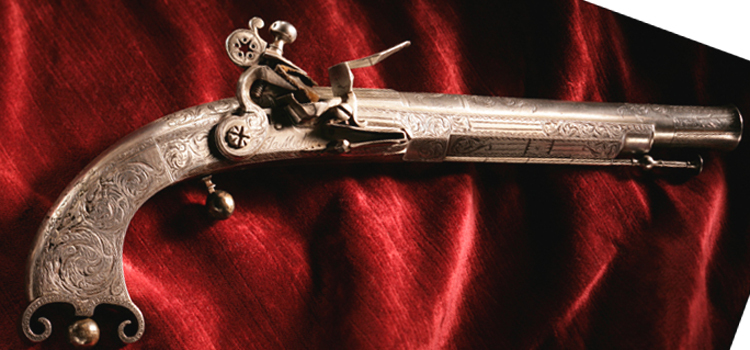 Here is a favorite of mine  This gun is one of the more "PLAIN" ones (NOTE - it was made by a British or Lowlander maker) 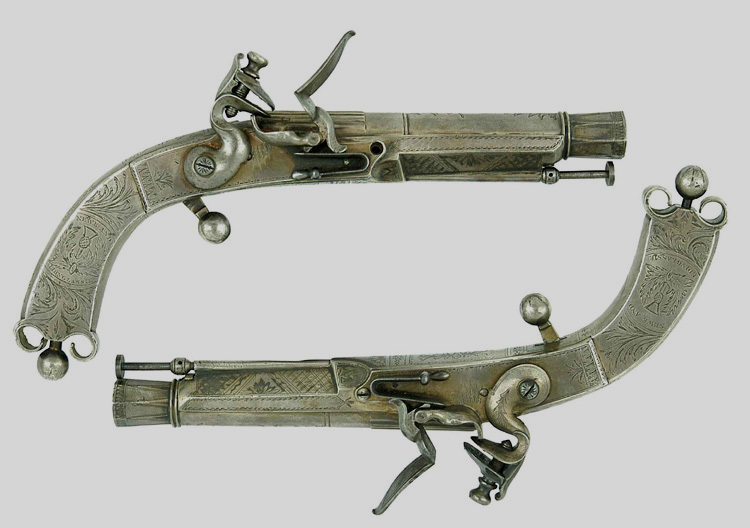 Finally, here is a "common one" 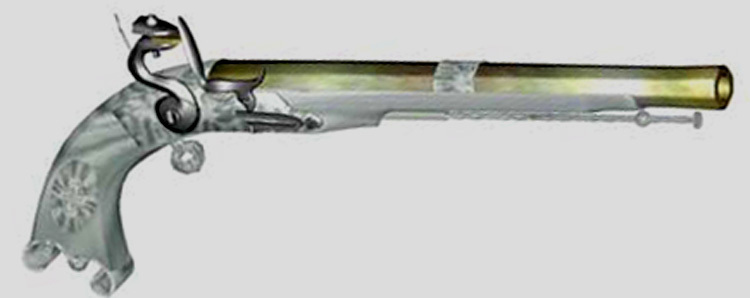 2. British examples - See earlier posts. 3. American examples ( not British or French imports ) - Please post examples I have several books with great examples of the above, but pics are copyrighted. See "Steel Canvas The art of American Arms" as a start. What I have found,is that, it appears that while British "presentation Guns Still had a great amount of "heavy" engraving ( as I showed before) The Engraving & decoration, became "finer" And the American Guns, even the presentation ones, were very simple. IMHO, this may point to "cultural" preferences. In other words if the income of the clientel was the same, then you catered to what they prefered. A NOTE on the American guns. Could the reason for the "lack of "engraving & decoration" be because of the American mind set ??? BTW here is a site I Know you have, but missed. http://www.picturetrail.com/gallery/...037&uid=717149 Puffer |
|
#84
|
||||
|
||||
|
Charles, you make great points. I am trying to offer my thoughts primarily based upon my experiences as an engraver, and one who seldom gets to do the higher end work that i would like too, BTW!
My historical knowledge is scanty, and is somewhat concentrated around the Moravians, as i worked at Old Salem for a time some years ago. The Puritan values, egalitarian impulses, and economic,war factors seem to be spot on, to me. I can't go any deeper than affirm that your suggestions seem valid. Thanks for putting the effort into this very interesting thread! take care, Tom |
|
#85
|
|||
|
|||
|
tom please don get mw wrong i think your possably very correct . im only trying to give alittle deeper prospective of what your saying .
please continue with your prospective , i think we all can learn from it 
|
|
#86
|
||||
|
||||
|
Here is something a freind in GB sent me. It is a pic of an engraving on a french pistol ca 1750-1800. I was done by a WOMAN engraver ( according to him.)
 Puffer |
|
#87
|
|||
|
|||
|
puffer ,
from what i can see i believe thatís the Trigger guard from a Huhnstock or Horneffer Jaeger rifle . of which is I believe the engraving and gilt back ground are attributed to the Stockmar family of Suhl. the were court gun makers for the Elector of Saxony . thatís very reminiscing of their work and yes I seem to recall one of their women folk did a engraving during a time . I believe that was about 1750 |
|
#88
|
|||
|
|||
|
Amazing Charles,
Thank you Hope you win. My Lindsay tool is outstanding. Gail in Boston |
|
#89
|
|||
|
|||
|
Since this post is speaking my language I'm gonna help you out.
As has been touched on before the expense in time to do work as has been pictured is emense, as the firearms became more avaliable they became more popular so had to be produced faster. The chiseled work was reserved for royalty and was presented as gifts, the functionality of a firearm was second to the art work. Very few builders made all of the parts themselves, the parts were purchased from the various suppliers, finished and assembled. Many of the firearms such as you posted will have several makers marks on them, lock, stock, and barrel, not to forget the engravers, typically all from different guilds. Of course this is concerning works of the highest order. There are several more books that relate to your post out there, probably the best is a two volume set called the Art of the Gunmaker vol. 1 & 2 by J.F. Hayward, I have yet to really get into them but they cover the art aspect of the firearms from 1500's through 1660 in volume 1 and 1660 thru 1830 in volume 2. My interest in this topic comes from learning to engrave for the purpose of applying it to the muzzleloaders I build, an all in one package. Plus I tried to win at this contest last year, wasn't happenin. I haven't bought Steve's equipment yet but I could. |
|
#90
|
|||
|
|||
|
T.G
i think you bring a very interesting point conserning works on guns and the guns themselves . See I think we commonly assume that during this time frame most all folks would have had some type of firearm . But this really doesn’t hold true especially in Europe. Where many of the different crown laws really made owning and carrying such a weapon , a privilege. We also assume that here in the US having a firearm was very common with every home and just about every male from a young age have one . However what is interesting if we look at the writings even as late as the Alamo , we find that descriptions of men showing up to fight with nothing more the pitch forks and axes , fairly common . We also find that many times those that did show up with firearms often had old out dated weapons , used to the point that reliability was questionable . Another interesting note about the Alamo itself . While it happened during what is considered the percussion lock era , not one of these weapons is listed to have been at that battle or in inventory Those who have read about Sgt York during WW1 for instance . Those that have not read of this medial of honor recipient may be fascinated to learn that upon enlisting , he showed up with a flintlock and had no experience with the cartridge weapons that had been in use for a very long time . While he was an expert marksman , he had to be trained in the use of the, new to him ,weapon system . I think however this comes back to the issue that in this country at least function was the rule of the day . Thus desired items had to be practical first and foremost, art being well down the list . Seems to me though , early in Europe the principle seems to have been different , IE . While the goods most certainly needed to be functional, they also had to be artistic in how the item presented itself , which also depicted status . Later as this became less of an issue and concerning firearms , they became more readily available , this heavy type of engraving became less . However most all still carried engravings of some sorts where the weapons produced for the colonial trade often had little to no engraving on them . those that did were not destined or produce with the common person in mind Very interesting point . Thank you for the post Puffer. here are a couple more of their works  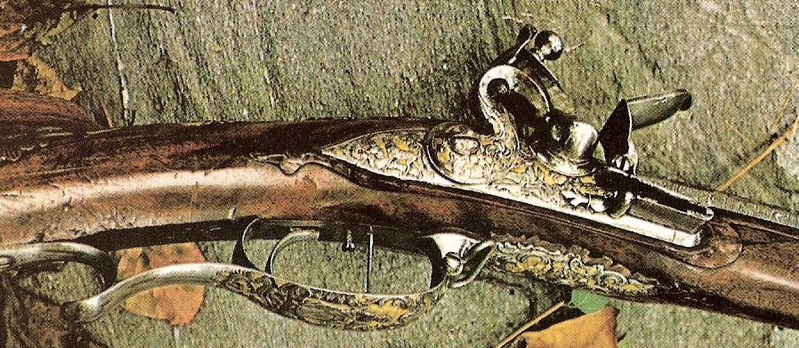
|
|
#91
|
|||
|
|||
|
Forgive the dumb question
What is the most used tool in hand engraving |
|
#92
|
|||
|
|||
|
Quote:
Take care in reading the writings as they are used in todays political arena. At this point lets agree to dis-agree. Here are a couple plates from vol. 1 of the above mentioned books. 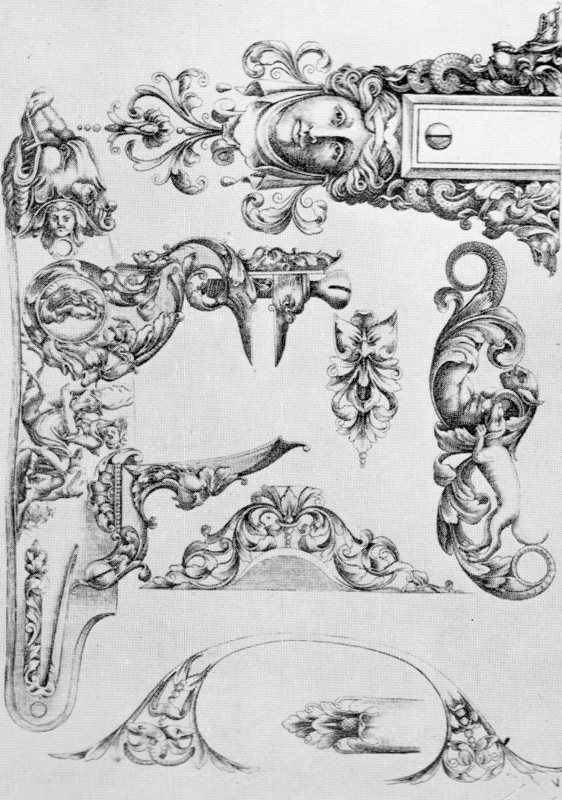 
|
|
#93
|
|||
|
|||
|
Quote:
ohh i would agree with you as the flintlock is still in use today . however that doesn’t change that caps started here in the US in 1820 " US paten date ". Europe 1810-12 "french and english paten dates "depending on what documentation you want to believe . My statement wasn’t meant to say that all folks used percussion rifles within that time frame. My personal opinion is they did not and in fact they never were as wide spread as we are lead to believe .. but for their quick spred in population areas . However that doesn’t change the facts that many of the fur trade listing show thousands of caps being brought to the fur trade rendezvous in the 1830 and well past 1840 which by the way isnt the actual end of the fur trade , just the last major gathering by the fur companies . Now within reason we simply have to accept that those caps were brought for a reason even though the documentation of rifles using them is somewhat lose /small . Hence the percussion era normally is accepted to be in this country 1820 -about 1880 thus covering the rise of this system and its decline . This doesn’t mean it did not last longer or that it did not start earlier . Only that it was the main so called hay-day of that system We can say the same thing about the so called golden age of the long rifle or the golden age of the SXS IE a general statement and a general time frame. however that doesnt change the documentation in diaries and dispatches describing adult males showing up for enlistment or musters with no weapon i also must agree that one must be careful . however what we must be careful with is our books , especially the really good older ones . Most of these were printed in a time of limited resources for study . Thus the writers often relied on museum documentation for their documentation . Which is another source we must be careful of as often times items are describe , listed and cataloged completely wrong. In todays age of internet resources , access to congressional libraries , church catalogs of actual writings + 100’s of thousands of other resources all on electronic data bases with 100sands being added each day , we often find that what we believed true , is dated . For instance , just recently the 1853 edition of Bishop Frederic Baraga's dictionary has been cataloged and added to electronic resources. Now many of the writings concerning a few of the eastern Americian Indian languages Is found lacking . Not because the resource has not always been there but because access to it for documentation has been limited . Thus to tie this back into the subject here . As we learn more and find more such resources , I have to wonder w hat will come in the future . How many of these old engravings that we are discussing may in fact be documented wrong or the suporting documentation was so light that it should be suspect , I guess only time will tell But no mater , I still love the old books . Especially ones like you posted , they have a class all their own that doesn’t seem to be able to be repeated today |
|
#94
|
||||
|
||||
|
Chas. thanks for IDing the pic.. Also thanks for the added pics.
I've got to run, but I will be putting some thoughts in, tomarrow, along the line of your last couple of posts. BTW - Unkown to many, there were a number of wonen involved in the gun making trade, at least in Britan ( example, the Hudson Bay Co.'s records show several continuing as major suppiers after their husbands death. Puffer |
|
#95
|
|||
|
|||
|
ok yess, im sorry i got way off track with that post , lets get back to period engravings . sorry
|
|
#96
|
||||
|
||||
|
Wha a great thread! Here is my questions, please don't mind if I have missed any thing that you have already post in your previous post as my English is not good
![Smile[2]](/images/smilies/top smiles/smile[2].gif) 1. I am very new to engraving and I am starting to know more who is Narskim or Churchchill (sorry really very difficult for me to remember the name, please forgive me) and know they affecting the the whole engraving trend in the USA, how about in Europe like French, Italy, Austria, Belgium? An engraver or a gun manufacturer in different period? The trend is the engraver's style, or the factory pattern style, the art trend in the fine art field has any affecting those popular "trend" or "style"? Are these style or trend affecting each other from country to country? 2. From you photo I found one wooden handle with very beautiful silver inlay (is this term correct?) Is this also call engaving? I try to search some more information about this technique but fail, can you give me some hints so I can dig it out. More question is coming, I am so greedy ![Smile[2]](/images/smilies/top smiles/smile[2].gif) The Lindsay's tool is very attractive, I love it so much when the first time I hold it in my hand........ Thanks again for the information of the wonderful books. Zernike |
|
#97
|
|||
|
|||
|
not to worry Zernike, some say my english isnt to good eather
Quote:
Quote:
Quote:
the silver inlay on the wrist of the rifle i posted is call a thumb piece or thumb inlay . this was either made from plate , inlet into the wood of the stock ,then engraved OR it was engraved and then inlet into the wood .. Now this piece could also be a casting of an earlier engraving , which is very commonly used today in place of actual engraving . Now the photo that Puffer posted is of a trigger guard . This also would be a casting and then the engraving done on the piece or cast into the piece . With the one in his photo however IMO this is relief engraving , not casting |
|
#98
|
||||
|
||||
|
Quote:
I believe you are refering to Louis D. Nimschke and Winston G. Churchill. L. D. Nimschke was born in Germany in July 1832. He immigrated to America about 1850. He died at the age of 71 around April 1904. He engraved until 1902. This link will give you some background: http://www.georgemadis.com/987/NL1-1.html Winston G. Churchill is a contemporary gun engraver of the highest reputation. He works from his studio in Vermont. He began as a gun engraver in 1969 with the firm of Griffin & Howe under the tutelage of the late master Josef Fugger. This link will give you some background on WGC: http://members.forbes.com/fyi/2006/1030/113.html Best wishes, Roger |
|
#99
|
||||
|
||||
|
After reading 96 posts on this thread, I am ready to chime in with my two cents worth.
I first want to thank Charles for starting this discussion about the history of the art. It has become obvious, due to this thread, that there are many here whose interests go beyond "teach me how to engrave." Next I have to say that I was surprised at comments early in this thread that indicated a belief that the type of engraving that Charles displayed in the beginning was not being done because contemporary engravers do not want to spend the time and effort to accomplish such work. Have you been looking at the pictures of top level work on this site or the Engravers Cafe?!!!! Contemporary engravers such as Ron Smith, Phil Griffnee, Alain Lovenberg, and Winston Churchill, among others, are doing work that takes thousands of hours for one gun. The guns are not usually done in the baroque style of Thuraine or Le Hollandois but are masterpieces of the engravers art to rival anything of the past. While I own hundreds of books on firearms and every book directly devoted to gun engraving, I can make this statement from first hand viewing of early guns in collections from the Museum of Hunting and Nature in Paris to the Metropolitan Museum of Art in New York and most recently the Frazier Museum of Historical Arms in Louisville to name but a few. Guns by Monte Mandarino have been mentioned. Monte has made a number of muzzle loading rifles in the style of those in question. This style of gun has also been made by John Bivens. In both cases Daniel Goodwin did the engraving. Parts of these guns can be seen on pages 55 and 56 of my book American Engravers. The gun on page 55 is a wheelock designed to conform to the Nuremberg style of 1690 with the butt plate shown on the next page. On page 56 is a side plate or "serpentine" of a Mandarino gun in the style of a German long rifle of the early 18th century. I have looked at and handled both of these guns and can assure you that the engraving is the equal of anything I have seen on antique specimens. Now let us proceed to the question of why the style in question is rarely executed today or even in the past 125 years or more. Some of the previous posts have, I believe, touched on the reason. Basically I believe that one reason is simply due to changing styles in everything from architecture to furniture over the same period of time. The wealthy who can afford ornate and expensive things are always looking for the "next big thing." Thus popular styles changed over time from baroque to rococo to neoclassical to art Nuevo to art Decco and so on. Another reason is the form of the gun itself. Muzzle loading guns lend themselves better to highly ornate decoration of the baroque and rococo style due to the configuration of the cock (hammer), lock, side plate, stock shape and barrel configuration. An additional factor was the decline or, as in the case of France, the elimination of the aristocracy who had favored the most ornate artifacts. Especially in America where the European aristocracy was even held in contempt, this distain for for the old order caused the highly ornate to be frowned upon. This can be seen in all American craft from furniture to guns of the colonial period. Because I personally like the baroque style I have, in the past, engraved a few things that way to test the market for that style and see if I could gain commissions for it. Generally the people who actually pay for engraved arms met this work with a lack of enthusiasm. Thus the market calls the tune unless one wishes to invest the time and money only for self-satisfaction. I hope I have added something useful to this discussion. The following books are ones that I can recommend for more illustration of the arms and engraving in question on this thread: Master French Gunsmiths' Designs (XVII-XIX Centuries) by Stephen C. Grancsay, Winchester Press. This book has all of the designs shown in Prof. Lenk's book plus many more. The Art of Gun Engraving by Claude Gaier and Pietro Sabatti, Knickerbocker Press. This book, in English (also found with French text) shows the best of the old and new from ornate wheelocks to the best of Lovenberg. Suhler Waffenkunst (Artistic Guns of Suhl) by Hans-Jurgen Fritze,Peter Arfman-Verlag. This book in German is replete with pictures of both antique and modern German guns of the most ornate decoration. Roger Bleile |
|
#100
|
||||
|
||||
|
Roger excellent post.
Quote:
This is a great thread and has kept me reading every day to see what's is new // also I agree that the talent on this forum is TOP SHELF alright. My earlier posts were a general statement about the country // While the talent is most certainly still out there, the use is not as wide spread as it was in earlier years // take buildings for example we construct a good strong build but we don't see the ornate elaborate brick work of even 75 to 100 years ago. I really believe it has to do with the amount of time we have to do the job. We as a society demand fast and thats lacks in quality when you reach a certain speed. I'm probbably rambling on but just my thoughts |
 |
| Bookmarks |
|
|